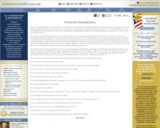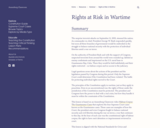
In this lesson, students will learn how Benjamin Franklin purposefully tried to be virtuous throughout his life.
- Subject:
- Social Science
- Social Studies
- Material Type:
- Lesson Plan
- Provider:
- Bill of Rights Institute
- Date Added:
- 09/12/2022

In this lesson, students will learn how Benjamin Franklin purposefully tried to be virtuous throughout his life.

One of the enduring features of our Constitution is its flexibility. At the time of its ratification, the population of the United States was around 4 million and today that population exceeds 332 million. Since its adoption the Constitution has only changed 27 times! Actually, since 1791 (with the inclusion of the Bill of Rights) it has only changed 16 times. That is an amazing fact considering the changes in technology, infrastructure, population, etc. in this country in more than 200 years.

Any member of Congress or state legislature can propose amendments to the U.S. Constitution. Since 1787, more than 10,000 amendments have been proposed. These proposals range from banning the desecration of the American flag to balancing the federal budget to altering the Electoral College.

This lesson has students learn about the purposes of government specified in the preamble of the Constitution. Students will use C-SPAN video clips to define what is meant by "establish Justice, insure domestic Tranquility, provide for the common defense, promote the general Welfare, and secure the Blessings of Liberty." As practice, students will apply their knowledge of these purposes by viewing real-life examples of government actions and identifying the relevant purpose of government. This lesson works well in classrooms with one-to-one devices and can be adapted to flipped classrooms.

This unique copy of the US Constitution was printed by Claxton and Babcock in Albany, New York, between February 11 and March 21, 1788. Copies of the Constitution were widely distributed following the document’s signing by the members of the Constitutional Convention on September 17, 1787, and six states had already ratified it. So why was this late printing even undertaken?

(Reading of the Declaration by actors)

In this lesson, students will learn about the actions of Paul Revere during his midnight ride in April of 1775. They will study how his diligence in working towards American independence helped to advance the cause and use this example to better understand how they can be diligent in their own lives.

In this lesson, students will gain an understanding of how the doctrine of incorporation broadened the application of the First Amendment. They will also gain an understanding of the facts of landmark Establishment Clause Supreme Court cases, evaluate arguments about the scope of the Establishment Clause, and assess the Supreme Court's interpretations of the First Amendment with respect to religion in public schools.

In this lesson, students will explore the evolution in the United States from religious toleration to religious liberty. Students will examine the difference between the two, analyze documents concerning both, and evaluate the significance of this change.

These lessons asks students to look not just at the events of 9/11 but at the following days and years. The lessons involve students in exploring the parts of a newspaper, the functions of a news article, and the importance of a free press in a democratic society. Classroom activities prompt students to discuss the need for and role of heroes. Students learn how to identify unifying factors in a diverse society, distinguish between fact and opinion, examine different points of view, analyze legal issues that have arisen as a result of the terrorist attacks, and much more. Lesson four, Todayâ"s Hero, also includes activities for grades K–4.

Case background and primary source documents concerning the Supreme Court case of Reno v. ACLU. Dealing with whether or not the First Amendment protected obscene or indecent speech on the internet, this lesson asks students to argue whether or not Congress should be able to ban "indecent" or "patently offensive" speech on the Internet.

In both a republic and a democracy, citizens are empowered to participate in a representational political system. They elect people to represent and protect their interests in how the government functions.

Teachers may request up to 100 free pocket Constitutions for their students.

In this lesson, students learn about responsibility and apply the concept to segments of the U.S. Constitution.

Since 2005, the "Past and Present" podcast from Colonial Williamsburg has taken you behind the scenes to meet interpreters, chefs, tradesmen, musicians, historians, curators, and more. We offer two versions of our podcast: one that's audio-only and one that includes a slideshow. In this episode: Each year, Colonial Williamsburg hosts Return of the Cherokee. This special event draws hundreds to observe Cherokee culture as it was in the 18th century when members would come to Williamsburg for trade, diplomacy, or even education. Buck Woodard with Colonial Williamsburg’s American Indian Initiative joins to explain some of the exciting updates to this year’s event.

In Reynolds v. Sims (1964) the U.S. Supreme Court ruled that states must create legislative districts that each have a substantially equal number of voters to comply with the Equal Protection Clause of the Fourteenth Amendment. It is known as the "one person, one vote" case. Justices struck down three apportionment plans for Alabama that would have given more weight to voters in rural areas than voters in cities.

In Rhode Island v. Innis (1980), the Supreme Court created the "functionally equivalent" standard for determining when police officers are interrogating a suspect. The Court ruled that an interrogation is not limited to direct questioning, but instead covers any actions that can be reasonably understood as coercive.

In order to enjoy our tradition of rights in the United States, we must also fulfill responsibilities to assure that all can benefit from the liberty and equality on which the United States was founded. Many of the rights we can exercise have concrete responsibilities of actions we must take to assure the common good. This lesson will examine the differences between rights and responsibilities, and how both relate to the concept of the common good.

The Declaration of Independence, based in part on the philosophy of John Locke, was an “expression of the American mind”. Going back to Magna Carta, British nobles had petitioned the monarch demanding limits to his power. But Locke argues and the Declaration of Independence asserts that legitimate government is based on the consent of the governed. Locke’s ideas were too democratic, too revolutionary for his time in England, but a century later they had a firm hold in the American colonies, and in 1776 they were the basis of the original and most fundamental American statement of rights, the Declaration of Independence.

This lesson is based on an Annenberg Classroom video Habeas Corpus: The Guantanamo Cases that explores the four Supreme Court cases known as the Guantanamo cases. These cases are examples of how the Court, the president and even Congress fought to balance national security and civil liberties during the war on terror, a war that continues to this day. At the hear of each case was the constitutional right of habeas corpus, the right to have one's detention or imprisonment reviewed in court.
This lesson is aligned with the National Standards for Civics and Government and Common Core Standards. The estimated time of this lesson is two 50-minute classes.